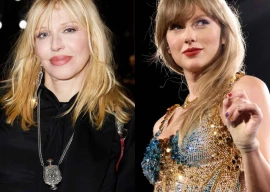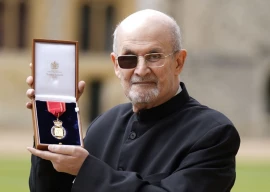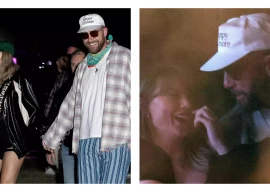
KARACHI:
“Let the beauty of what you love be what you do,”
Rumi
During these last days of winter, or the first of summer, when season itself is so near, rhapsodic, it is right to speak of Rumi in the context of art. February 12 marked the third anniversary of Koel Gallery, in Karachi. An exhibition entitled, “Mein — The Artist and the Self”, displays 85 self-portraits made by artists, sculptors, photographers, as well as architects, who have shown at the gallery since its inception in 2009.
The opening night event was magical. The space of Koel, overwhelmed by its audience as in the spirit of a festival. Days later, students and teachers alike, lay viewers, continue to stream into the premises. To an observer of such uninterrupted flow and aesthetic engagement, Koel Gallery looks like another country.
With the institution of Noorjehan Bilgrami begins a kind of romance. Artist, author, designer and educationist, she first came upon the idea of a gallery in 1989. Koel workshop had been some 12 years in the running, a pioneering effort directed towards the preservation of handloom and block print traditions in Pakistan.
As its organic extension, “Maharat” was intended to showcase works of excellence, both in the idiom of craft as well as indigenous art. The then small, mud walled space was inaugurated with an exhibition by late Zahoorul Akhlaq. Several projects and metamorpheses later, the gallery resurfaced in its current location. But despite Koel’s expansion, the original spirit of zen-like simplicity and quietude continues to mark the space. It seems to belong to everyone.
Over 50 shows have been held at the gallery thus far. Ms Bilgrami is assisted in her curatorial practice by an advisory board including architects Habib Fida Ali and Arshad Faruqui, photographer Amean J and artist Ussman Ghauri, before his tragic loss last year.
Despite their inherent diversity, concern for craftsmanship and a taste for the sublime seem to define Koel’s curatorial sensibility. The best shows have often a meditative effect, in terms of subject matter, aesthetic integration, and interior historic awareness. The current exhibition however, exceeds, indeed consumes the gallery’s own parameters. It is noisome, congenial, young and densely conversational. One might even sense the articulation of a dozen thematic shows, within the single framework of self-portraiture.
Large works, such as Imran Mir’s flamboyant “Picasso and Me…Confused” or Kakul Kamran Kureshi’s sprawling “Kitchen” draw one’s immediate attention. On a more sobering note, artists such as Mehr Afroz, Nahid Raza, and Mussarat Mirza refer the viewer to their signature style, in place of works of sensuous resemblance. Pure abstraction, unusually the purview of women artists, hangs amidst vocal designations of self, as defined by political and social commentary. Humour too finds an honourable place in the show, with works such as Amin Gulgee’s “Born This Way”, Saba Khan’s “Bad Karma”, or Hamra Abbas’s cavalier digital self-portrait.
Amidst the diversity of images and expressive media however, the most powerful works at Koel remain within the ambit of conventional portraiture. By this I mean the staging of a singular, embodied self, physically and viscerally featured. Both Naazish Ataullah and Aasim Akhtar draw from this premise and use physical form as the central subject of their works. The intimacy of their photographic images stand out in the exhibition.
In another case, an early work submitted by Naiza Khan shows a face engraved in cherry wood. The remarkable intensity of her line and colour surface across the wood’s tightly packed grain. It creates in the image an inwardness that is itself hard to contain. In a corresponding light, and despite its burnt, bright orange hues, Asim Butt’s oil painting excludes the world. Meaning pours into his face, only and as a result of this gesture. (Asim’s work has been included in the show in remembrance of the artist’s acute presence, past his death.)
Such singular and sensually introspective expositions inaugurate, at Koel, a genuine narrative of self in contemporary Pakistani art. As an undertaking, the project’s relevance is apparent in both artists’ response as well as the groundswell of viewers witnessed at the show. At once playful and polemical, and on occasion painfully honest, “Mein” marks a coming of age for the gallery. For Ms Bilgrami and co-curator Amean J, it is surely a moment of acknowledgment.
Published in The Express Tribune, February 17th, 2012.










































COMMENTS
Comments are moderated and generally will be posted if they are on-topic and not abusive.
For more information, please see our Comments FAQ